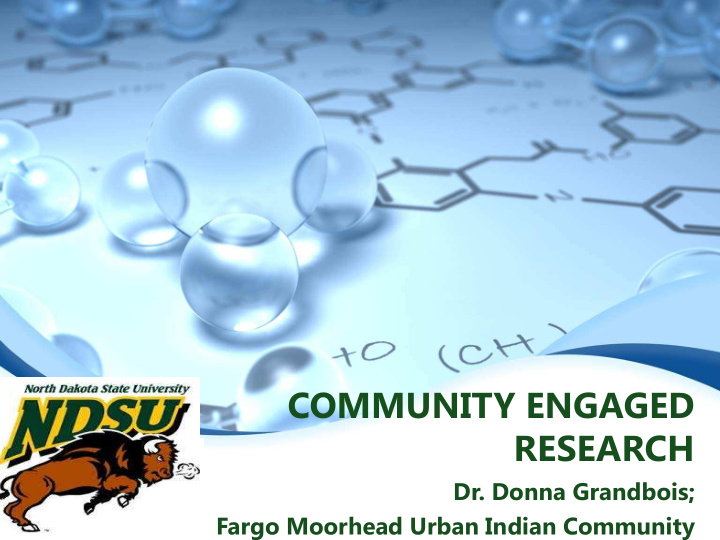



COMMUNITY ENGAGED RESEARCH Dr. Donna Grandbois; Fargo Moorhead Urban Indian Community
“A NATIVE AMERICAN COMMUNITY’S JOURNEY TO ACHIEVE CULTURALLY APPROPRIATE HEATH CARE”
KEY PREMISES The Community has the Expertise POINT 1 The Indigenous Worldview Matters! POINT 2 Our Cultures Hold Our Medicine POINT 3 Care Must Be Community-specific POINT 4 The Community is Dynamic POINT 5 Cultural Humility & Respect is Intrinsic POINT 6
THE PROBLEM Healthcare services do not exist for urban Indians w/o insurance in North Dakota: Indian Health Services are not within easy driving distances Many Urban Indians do not have tribal IDs There are no FQHC for Urban Indians in ND or Title V funding for services Fargo FQHC has not welcomed Native clients Lack of data contributed to the problem Low health literacy
Demonstrated Need for Community- Specific Data: North Dakota was ranked “#1” by both Gallop & Healthway’s for the highest “well-being scores” across the US. Rankings were based on 6 Measures: a) Access to basic needs b) Healthy behavior c) Work environment d) Physical health e) Emotional health f) Life evaluation & optimism (Dakota Nurse, v 12, 2, Spring 2014; p. 15)
The Stark Reality for North Dakota’s Indian People: Cradle to grave inequities NATIVE AMERICANS NON-NATIVE POPULATION Approximately 42,000 Approximately 672,000 • • Median household income: Median household income: • • $25,255 (49.7% below 200% FPL) $48,670 Unemployment: 14% Unemployment: 3% • • High rates of disability at every Low disability rates • • age Among the highest High • The lowest High School School Graduation rates in • Graduation rate in the country the country Infant mortality rate 13.5 Infant mortality rate 7.5 (US) • • Life Expectancy 54.7 years Life Expectancy 75.7 years • •
Race in the Northern Plains Source: US Census Bureau, 2006-2008, American Community Survey ND, SD, Iowa, & Nebraska
BACKGROUND Urban Indian Health & Wellness Center Established with 6 Native Board Members Held community forums & dialogues Greater Fargo Moorhead Community Health Needs Assessment Collaborative (CHNAS) (20 members; in response to 2010 healthcare reform mandate) Only 2 Natives completed the CHNAS survey Native American City commission funded the Native American survey; using the same tool 7-8 Native community members IRB certified to collect data (101 surveys/88 Native)
COMMUNITY STRENGTHS
Greater F/M Community Health Needs Assessment Collaborative C. Fuglesten-SE Human Services M.Miller- Center for Rural Health C. McLeod- Sanford Health M. Henderson- Family Healthcare Center (FQHC) D. Watne- Dakota Medical Foundation P. Patrone: Family Heathcare Center D. Grandbois- American Indian Pop. R. Danielson-NDSU G. Nolte-Clay County Public Health R. Rathge- NDSU K. Olson-State Data Center R. Bachmeier- Cass County Public Health K. Dulski- Essentia Health S. Thomsen-United Way Cass/Clay K. Schwarzwalter-NDSU S. Borgen- Essentia Health K. Lipetzky- Fargo Cass Public Health T. Hill- United WAy
What is CBPR? “... a truly collaborative approach to research that equitably involves all partners in the research process and recognizes the unique strengths that each brings. CBPR begins with a research topic of importance to the community and has the aim of combining knowledge with action and achieving social change to improve health outcomes and eliminate health disparities . ” Source: Kellogg Health Scholars Program. [cited 2012 November 13]. Retrieved from: http://www.kellogghealthscholars.org/about/community.cfm
Community-engaged Research Principles Recognizes community as a unit of identity Builds on strengths and resources Facilitates partnership in all phases of research Promotes shared learning to solve social inequalities Addresses health from positive and ecological perspectives Disseminates findings and knowledge to all partners Involves long-term commitment by all partners Source: Adapted from : Israel, BA, Schulz, AJ, Parker, EA, Becker, AB, Allen, AJ, and Guzman, JR. “Critical Issues in developing and following CBPR principles,” Community-Based Participatory Research in Health, Minkler and Wallerstein (eds), Jossey Bass, 2000.
METHODS A mixed-method community-based participatory research (CBPR) collaboration with the F/M Urban Indian community was implemented. Phase I: Urban Indian volunteers were IRB certified by NDSU Native American City Commission funded the survey Survey was conducted by community members Both paper & computer access to the survey were provided. Group Decision Center, NDSU, was used to collect the surveys and provide a report on the results
PHASE I Began with Relationship Building & Community Service. Relationships were built with: Community Coalition • Grass-roots community organizations • Native & Non-Native Leadership • Community Dialogues & Forums were held • Key Native Elders • Phase One included the community-wide survey & the community-specific survey
PHASE II: Building on Phase I Adapt the survey tool to be Native specific Define culturally appropriate care for “this” community The voices of the Elders must be sought out & included in focus groups American Indian Community Leaders must be asked to participate Semi-structured focus groups and individual interviews will be conducted to further define, clarify, and provide future direction
OUTCOMES; SO FAR! Capacity to generate their own data as needed • Awareness of biopsychosocial and economic status • Determine & set priorities to address specific needs • Support community focused grant applications • Community buy-in with the larger community: Be • recognized as a viable partner in key community health and socioeconomic strategic plans Monitor their own progress toward becoming a healthy • community
Outcomes; Possibilities, & Dreams Native community leaders can support and make a case • to local, state, and federal policy-makers and legislators, using the data, to meet community needs With ACA, more urban Indians will have insurance; • Therefore, access issues toward culturally compatible • healthcare services may need to be re-envisioned. Finally: Community Empowerment The data and the development of community cohesiveness, partnerships, and collaborations are vital as this urban Indian community works to build a healthy, welcoming community.
A Ways To Go! SOCIAL JUSTICE “Enables people to claim their human rights, meet their needs, and have greater control over the decision- making processes that affects their lives” HUMAN RIGHTS COMMISSION North Dakota Human Rights Coalition (NDHRC) was formed as recently as 2002. There is Native representation!
THANK YOU FOR YOUR TIME & ATTENTION! ANY QUESTIONS?
Recommend
More recommend